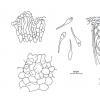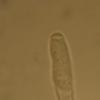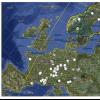
15-12-2025 07:09
 Danny Newman
Danny Newman
indet. Rutstroemiaceae sp. on unk. fallen leavesMc

15-12-2025 21:11
 Hardware Tony
Hardware Tony
Small clavate hairs, negative croziers and IKI bb

15-12-2025 15:54
 Johan Boonefaes
Johan Boonefaes
Unknown anamorph found on the ground in coastal sa

15-12-2025 15:48
 Danny Newman
Danny Newman
Melanospora cf. lagenaria on old, rotting, fallen

15-12-2025 07:05
 Danny Newman
Danny Newman
Pseudosclerococcum golindoi (det: Zotto)near Cosb

15-12-2025 11:49
 Danny Newman
Danny Newman
ITS sequences from the following two collections B

15-12-2025 12:34
 Danny Newman
Danny Newman
indet. Rhytismataceae on oak leafnear Purchase Roa

09-12-2025 12:06
 Andgelo Mombert
Andgelo Mombert
Bonjour,Je recherche l'article concernant Hypobryo
Salut à tous,
I hope someone can help me put a name to this pretty Orbilia, found last week on snow-covered Salix branches in the South of England....
Ascospores 17.1-19.6 x 2.3-3.2 µm
Asci thickened at the tips - Barely blue in Lugol's
No croziers observed
Merci beaucoup pour votre aide,
Nick

again I am admiring your drawing, including the inversely oriented spores! Itz is Orbilia aristata. Previously called O. occulta, but that species turned out to have shorter spores with shorter spore heads, and is only known from N-America.
Only one thing: how did you obtain such blue apical thickening? I studied thousands of Orbilia asci and they were always inamyloid. But rather lately I learned that they stain red with Congo Red, particularly CR-SDS.
By the way, the three spores without spore bodies are probably dead, rather than immature. This is often the case with free spores found in a water mount.
In order to get a better image of its distribution, I would ask you for the collection data to include your find in our monograph of you don't mind.
Zotto
Thanks for the quick reply!
I'm glad you asked about the ascus tips because I'm a little colour-blind.... Can you see any blue in the photos of my asci below? I had convinced myself it was there....
I should also say that I couldn't see blue on all the asci, so pehaps it is some strange artefact?
After a quick look at our UK database, O.aristata does not seem to have an entry (yet!), and Orbilia occulta (Rehm) Sacc. 1889 seems to be synonymised with O.cruenta (!!)
Collection data:
On Salix (caprea?) 100m, Tilgate Park, West Sussex, UK 18/1/13
Amitiés,
Nick

we also see a little blue in one of the two asci. Surely an atrifact, maybe of illumination. But I cannot see the iodine, it seems very low-concentrated. Usually it stains the ascoplasma yellowish, when it should stain an apical ring.
O. curenta is a nomen dubium. Massee and Nannfeldt put very different species together because they did not see the spores clearly.
I assume from your photo that the apothecia were on bark, right?
Did you keep the specimen and has it a number?
Tilgate Park is a little large, can you tell me more precisely the place? near one of the two lakes? Or the parking area?
It is the first record I see from UK/Ireland. But I thought that Ellis & Ellis have it? Yes: p. 12 and 249, on Salix, as O. occulta.
Zotto
Sorry, I should have included a UK gred reference: TQ 26687 34430. Yes, on bark. I've assigned the number 235 and will keep it in my personal herbarium.
I see now the description in Ellis & Ellis - I forgot they didn't illustrate all of the species!
I'll add a little more iodine to my Lugol's too! :)
Many thanks for your time & patience,
Nick
I realise that this is not my enquiry, but I do have a British record for Orbilia cf. occulta (identified by Brian Spooner) growing on a thorn of Rosa canina from Chaddesley Wood, Worcestershire. This was also found in January.
The spores were slightly shorter than for Nick's sample at 13 - 17.5um.
To feature in my book as Orbilia cf. occulta, though I did suggest to Kew at the time that O. aristata was a possibility. The sample was retained at Kew as K(M)169475.
Best wishes,
Peter Thompson.
Yes, I live in Crawley.
Peter - Thanks for the details - I look forward to your book (I think we need a taxonomically up-to-date work covering UK Ascomycetes!)
Nick

you do not have a spore sketch of your find? There exists also O. clavuliformis (ined.) with more elongate spore heads and thicker and shorter tails, spore size very similar.
Zotto




